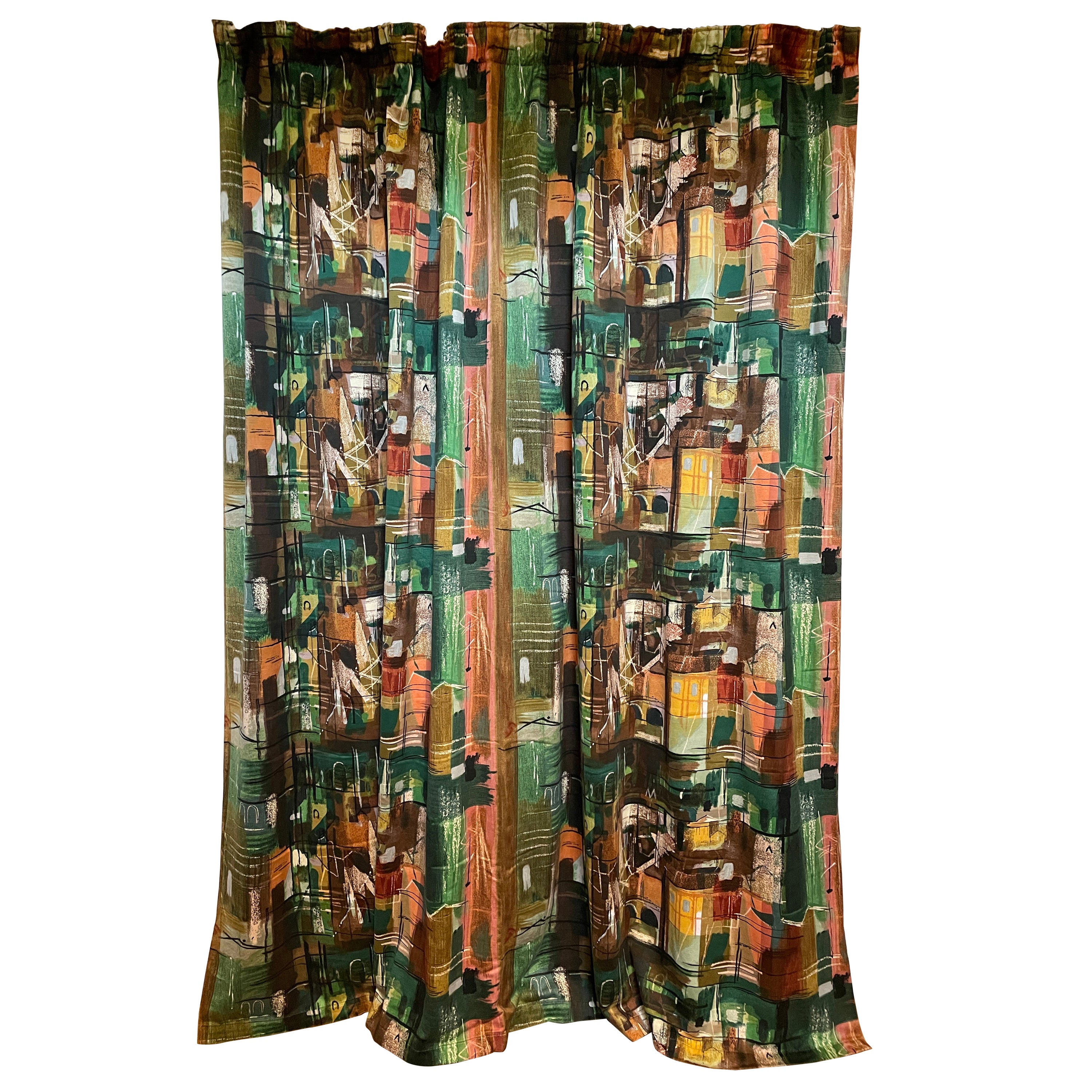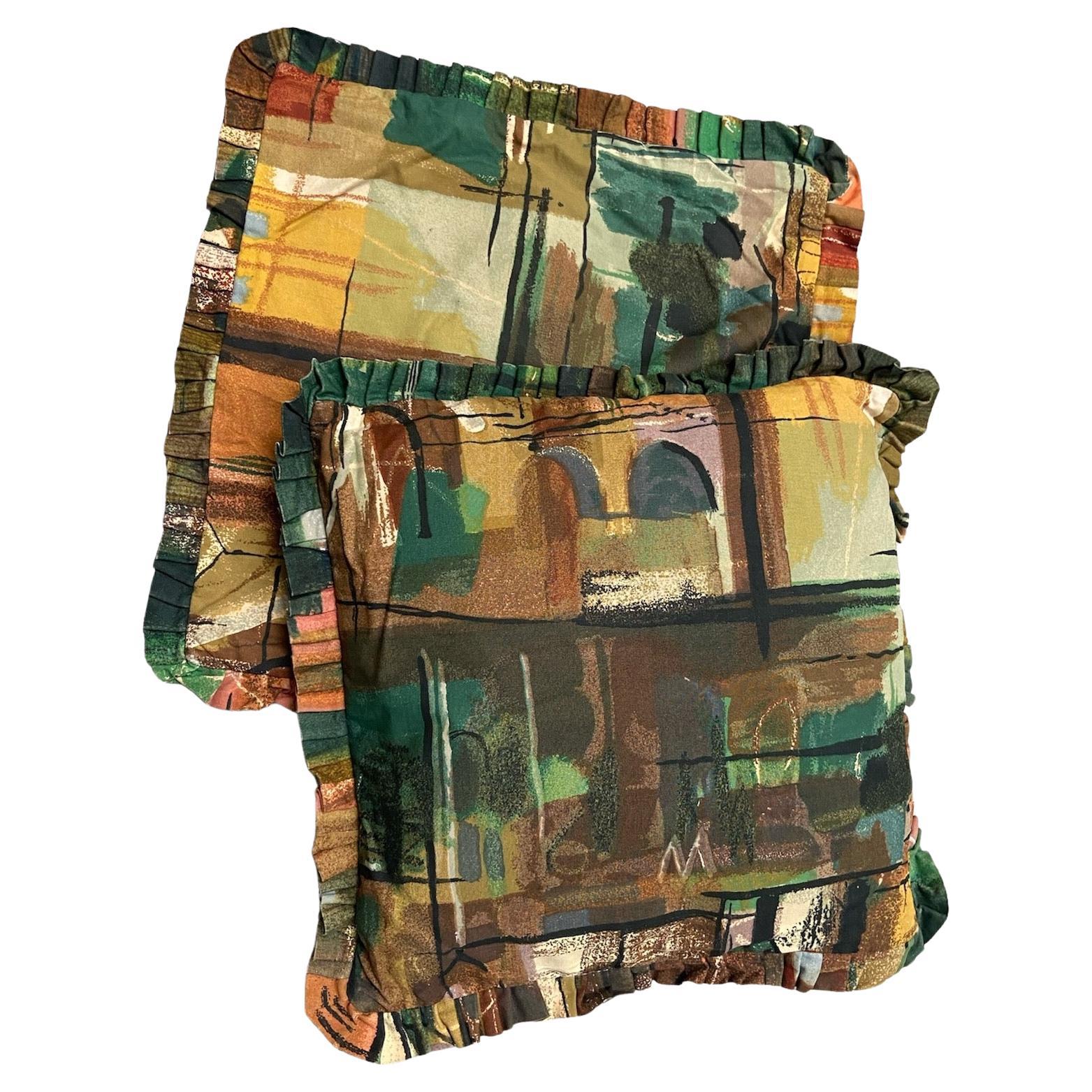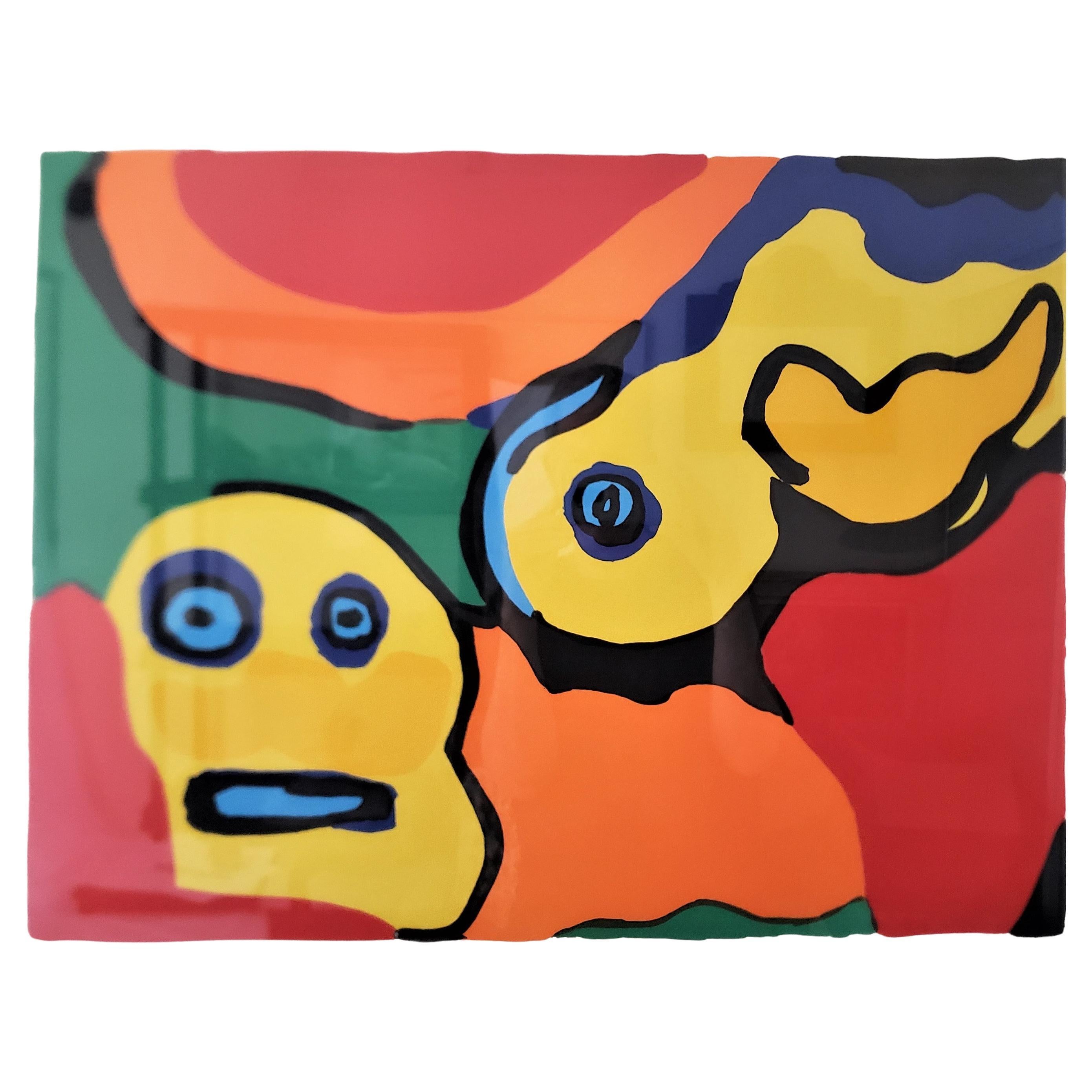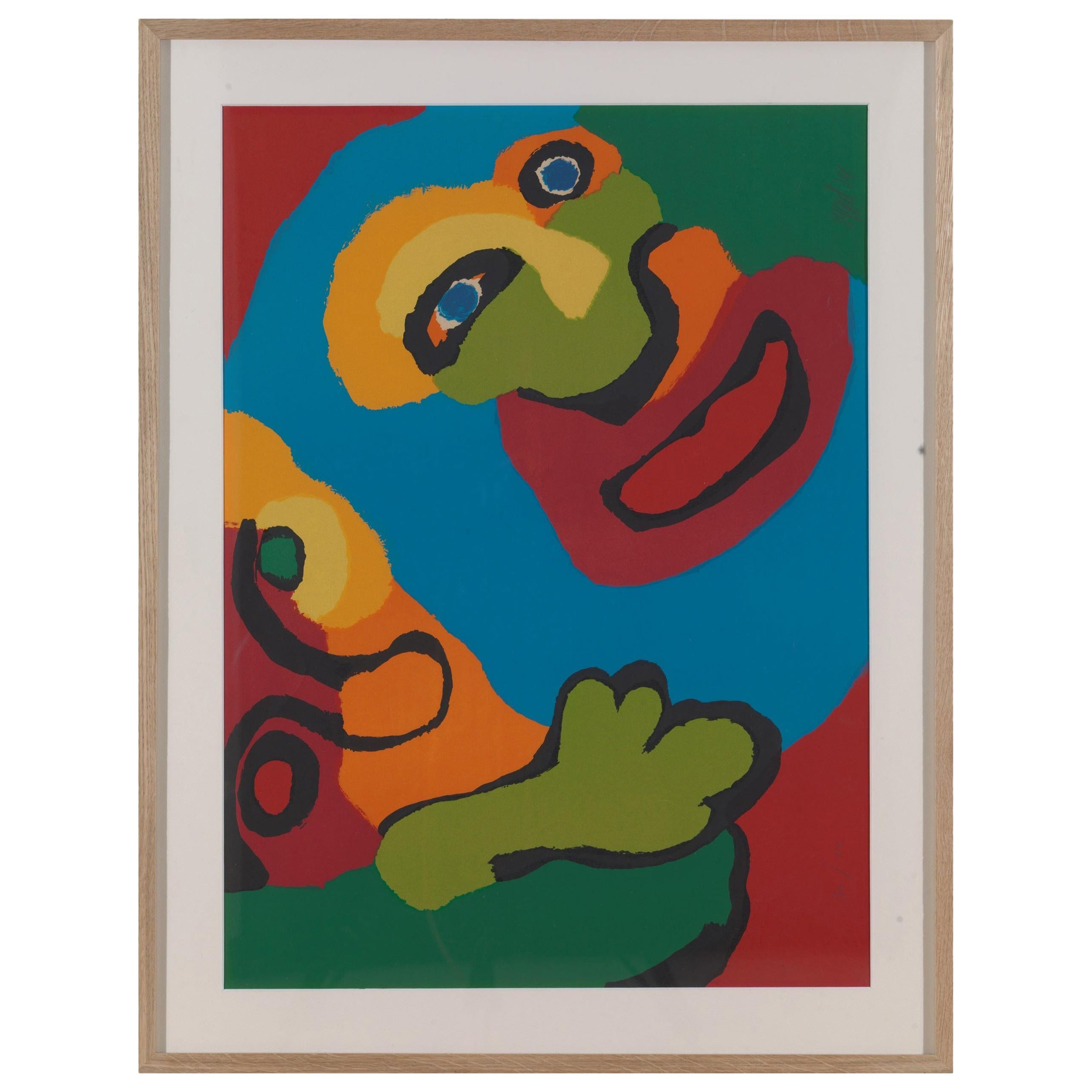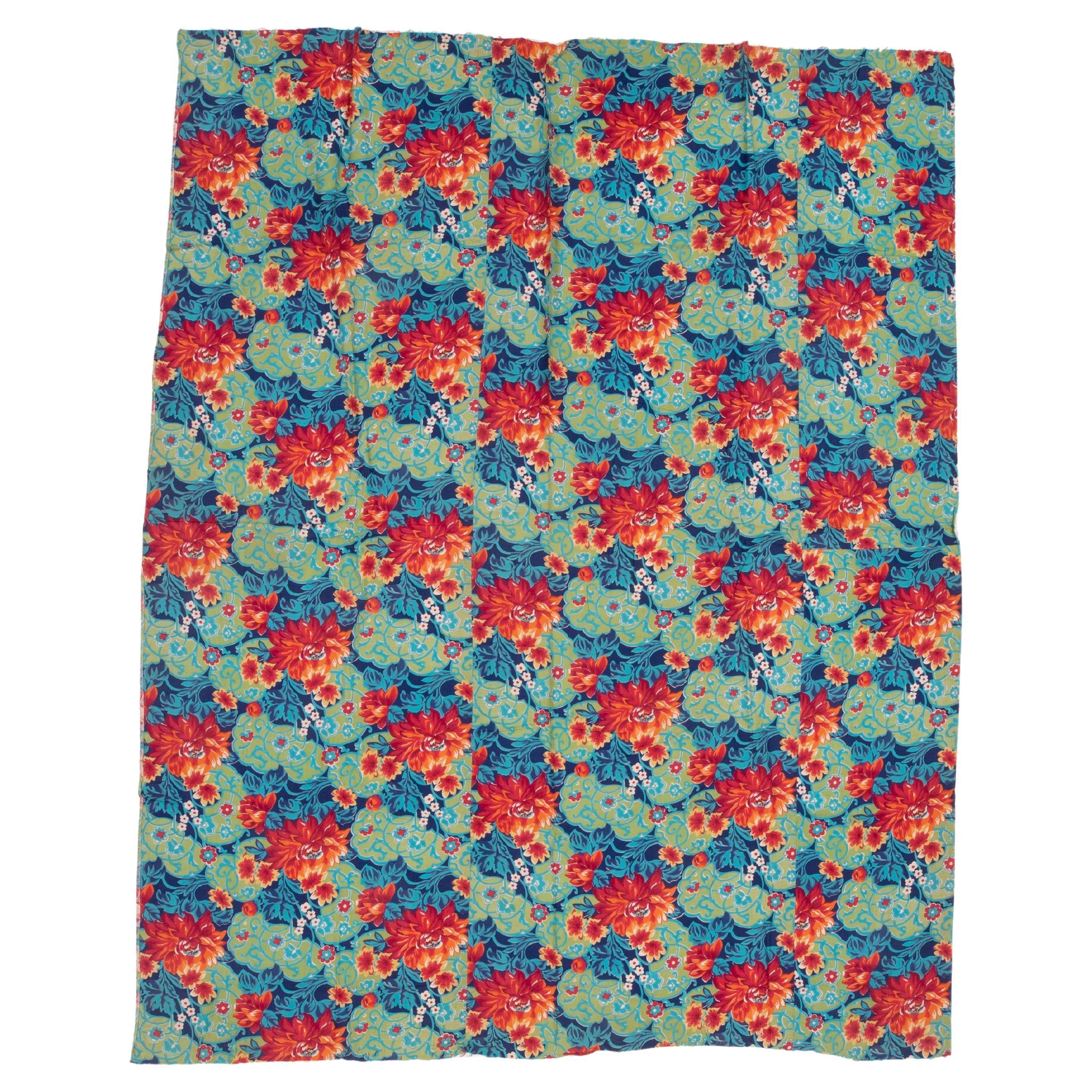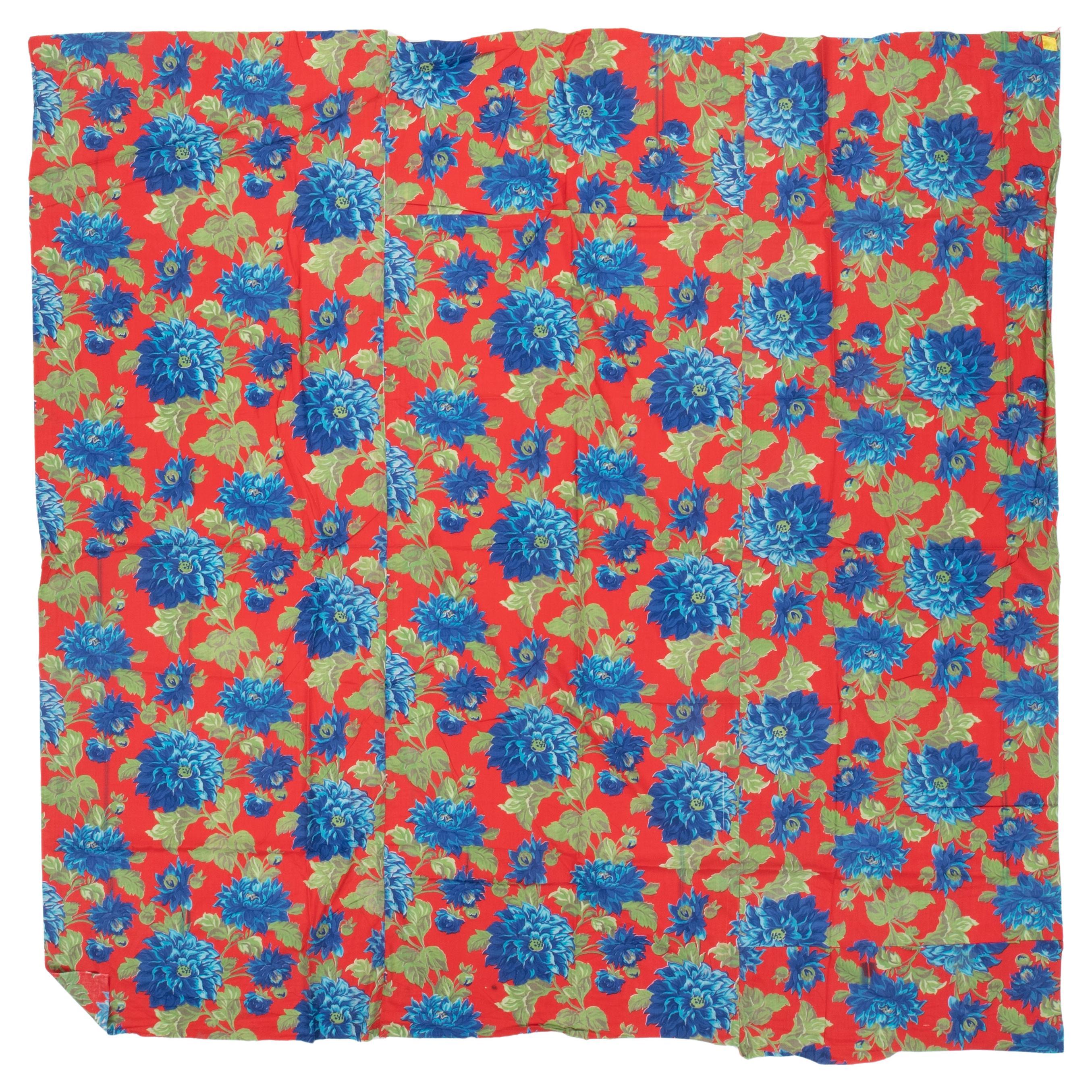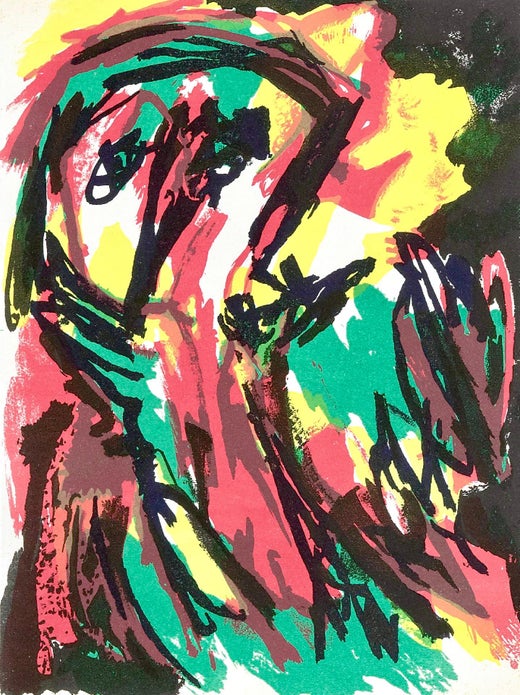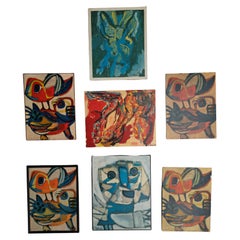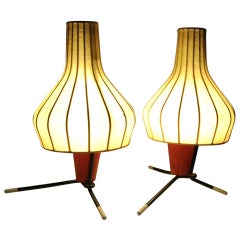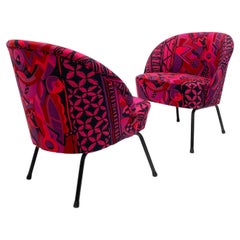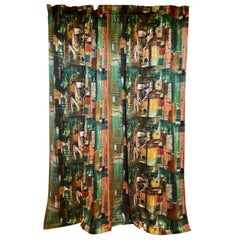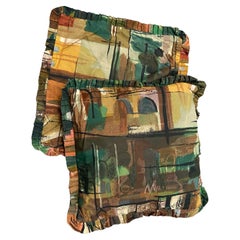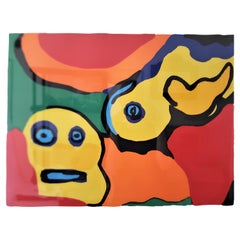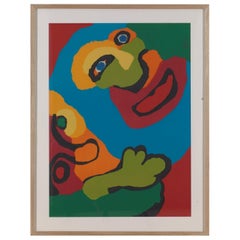Items Similar to Pair of Karel Appel Curtains, 1963, Documented at Stedelijk Musem
Want more images or videos?
Request additional images or videos from the seller
1 of 11
Pair of Karel Appel Curtains, 1963, Documented at Stedelijk Musem
$4,500per set
£3,383.64per set
€3,929.22per set
CA$6,284.16per set
A$6,969.59per set
CHF 3,660.09per set
MX$85,591.57per set
NOK 46,333.25per set
SEK 43,692.88per set
DKK 29,316.33per set
Shipping
Retrieving quote...The 1stDibs Promise:
Authenticity Guarantee,
Money-Back Guarantee,
24-Hour Cancellation
About the Item
Super rare and impressive pair of large cotton ''gordijnstof' curtains, designed in 1963 by world renowned Dutch painter and sculptor Karel Appel (1921-2006) for the textile company Hermann Hartman & Co of Amsterdam.
This extremely rare, original repeat print textile is documented in the Stedelijk museum's textile collection under object nubmer KNA 1998, please see image 2.
Each curtain measures 56.7" X 83.85" (144cm X 213cm).
'Gordijnstof' translates as "curtain fabric" confirming that this textile was originally designed by Appel specifically for use as curtains however being of such an impressive dimension these examples could equally be used as wall hangings ,as photographed, or mounted on both sides of a screen or mounted and framed as an art work in its own right , a practice which is becoming increasingly commonplace as high end textile designs by important artists are becoming increasingly valued , appreciated and sought after in the marketplace.
Appel's paintings and sculptures can be found in the collections of some of the world's most prominent museums including the Museum of Modern art in New York and Tate Modern ,London.
Each curtain is of a very impressive scale with each measuring
56.7 " (144 cm) X 83.85" (213cm).
The curtains are signed on the banding KUNSTENAAR DESSIN ONTWERP Karel Appel, HARTMAN PRINT, AMSTERDAM. Another of Appel's designs for Hermann Hartman,Amsterdam can be found in the collection of the national textile museum in Holland. Please see image 9.
Even a small sample of this 1963 textile in good condition would be hard to find today but to find two large scale Appel curtains intact and in beautiful unfaded condition with no staining or fraying must be next to unique today. This is a very rare find and certainly a unique opportunity.
Image 10 shows Karel Appel in his atelier in New York in 1966.
Provenance:
These curtains come from the private collection of a retired Professor from Oxford,UK.
Biography:
Karel Appel was an Expressionist Dutch painter. He was a member of the famous Cobra, the European group of the late 1940s to early 1950s, which promoted spontaneous expressionism and abstract features in painting. Appel's paintings incorporate applications of vibrant, violent colors often possessing a primal, childlike quality or a schizophrenic innocence. Later in life, Appel turned to creating figurative sculptures. Examples of his work can be seen in the Museum of Modern Art, New York City, Boymans-Van Beuningen Museum, Rotterdam, and other collections. Expressionist painter Karel Appel made a name for himself in the world of painting by creating a majestic collection of highly distinguishable work for which he became internationally renowned. From the start, art curators could not ignore Appel's work, which has been exhibited at major museums around the world, including New York's Museum of Modern Art, the Manhattan-based Guggenheim Museum, the Museum of Fine Arts in Boston and the Tate Gallery in London. Though Appel is widely recognized as one of the best-known Dutch Expressionist painters of all time, he was also a passionate printmaker, sculptor, and ceramicist.
Karel Appel’s childhood and early life
Christiaan Karel Appel was born on April 25, 1921, in his parents’ house at 7 Dapperstraat, Amsterdam. His father, Jan Appel, owned a barbershop. His mother, born Johanna Chevalier, was a descendant of French Huguenots. Karel Appel had three brothers. He studied art from 1940 to 1943 at the Rejksakademie van Beeldende Kunsten, the Royal Academy of Fine Arts during the German occupation and befriended young painter Corneille and, some years later, Constant. His parents opposed his choice to become an artist, leading him to leave home. This was also necessary to hide himself from the German police so that he would not be picked up and sent to Germany to work in the weapon industry. Appel produced his first real painting on canvas, which was a still life of a fruit basket at the age of fourteen. On his fifteenth birthday, his wealthy uncle Karel Chevalier gave him a paint set and an easel and some lessons on painting.
Career.
In 1946, his first solo show was held in Groningen, Netherlands. He also participated in the Jonge Schilders exhibition at the Stedelijk Museum of Amsterdam nd created a buzz in the art world, as it generated a huge scandal and many objections in the press and public. About this time, Appel was influenced first by Pablo Picasso and Henri Matisse, then by the French brute-art artist Jean Dubuffet. In 1947, he started sculpting with various used materials and painted them in bright colors such as white, red, yellow, blue and black. Karel Appel became the member of Nederlandse Experimentele Group in Holland along with the young Dutch painters Anton Rooskens, Theo Wolvecamp and Jan Nieuwenhuys. Belgian writer Hugo Claus also joined the group afterwards.
In 1948, Appel joined the Cobra group an acronym for Copenhagen, Brussels and Amsterdam—the hometowns of the founding members. The Cobra movement, which pushed spontaneous expressionism and abstract features, represented a turn from the more formal, geometric European art of the time. Cobra members believed painting opened a porthole into the human psyche. He was accompanied by Dutch artists Corneille, Constant and Jan Nieuwenhuys and the Belgian poet Christian Dotremont. Although the COBRA group did not gain any popularity in Netherlands, it was very well received in Denmark. By 1939, inspired by Danish and Nordic mythology, Danish artist had already started making spontaneous art. In 1949, Appel painted a mural for the cafeteria of the city hall in Amsterdam. The piece named “Questioning Children”, which portrayed the smiling, yet mourning faces of the children abandoned after the war, created so much controversy and made city hall workers so uncomfortable that it was covered for nearly a decade. In the face of hostile Dutch reactions, Appel moved to Paris in 1950 together with Constant and Corneille. Appel then travelled to Mexico, the USA, Yugoslavia and Brazil and earned international reputation. He spent several years living between Florence and New York City. While in Paris, Appel befriended Danish painter Jorn and Hugo Claus, the Flemish poet, novelist and playwright who later in 1962 wrote an extensive study on Karel Appel’s work. During the 1950s, Appel fell in love with the jazz movement and painted portraits of jazz masters Dizzy Gillespie, Miles Davis, Count Basie, and Sarah Vaughan. In 1954 Karel Appel received the UNESCO prize at the Venice Biennale.
Death And Legacy.
Appel died on 3 May 2006 at his home in Zürich, Switzerland. He had been suffering from heart ailment. He was buried on 16 May 2006 at the Père Lachaise Cemetery in Paris, France Years before his death, Appel established the Karel Appel Foundation, whose purpose is "to preserve [Appel's] artworks, to promote public awareness and knowledge of Karel Appel's oeuvre and to supervise publication of the Oeuvre Catalogue of the paintings, the works on paper and the sculptures." In the wake of his death, the Foundation (based in Amsterdam) functions as his official estate in addition to its primary service as an image archive. The U.S. copyright representative for the Karel Appel Foundation is the Artists Rights Society. In one obituary, New York Times writer Margalit Fox described Appel's legacy as, "Some critics discerned violence or even madness in Mr. Appel's work, with its liberal use of red and its semi-figurative images of grotesque limbs and distorted, grimacing faces. But to other viewers, the unrestrained masses of paint, which Mr. Appel sometimes squeezed onto the canvas straight from the tube, embodied the life force itself.".
- Creator:Karel Appel (Artist)
- Dimensions:Height: 56.7 in (144 cm)Width: 83.86 in (213 cm)Depth: 0.16 in (4 mm)
- Sold As:Set of 2
- Style:Mid-Century Modern (Of the Period)
- Materials and Techniques:
- Place of Origin:
- Period:
- Date of Manufacture:1963
- Condition:Wear consistent with age and use. Lovely original condition, fabric shows very strong colors and very little wear, as far as I can see next to no fading. The brown lining has a tear and can be easily renewed, it is not part of the original Appel fabric and was an added sun block.
- Seller Location:bergen op zoom, NL
- Reference Number:1stDibs: LU93014767743
Karel Appel
Karel Appel was a founding member of COBRA, an art movement originating in Germany that strived to replicate and invoke the child’s approach to art. Within this movement he created abstracted and simplified figures, often monsters and fractured depictions of people.
About the Seller
4.9
Platinum Seller
Premium sellers with a 4.7+ rating and 24-hour response times
Established in 1999
1stDibs seller since 2012
404 sales on 1stDibs
Typical response time: 1 hour
- ShippingRetrieving quote...Shipping from: bergen op zoom, Netherlands
- Return Policy
Authenticity Guarantee
In the unlikely event there’s an issue with an item’s authenticity, contact us within 1 year for a full refund. DetailsMoney-Back Guarantee
If your item is not as described, is damaged in transit, or does not arrive, contact us within 7 days for a full refund. Details24-Hour Cancellation
You have a 24-hour grace period in which to reconsider your purchase, with no questions asked.Vetted Professional Sellers
Our world-class sellers must adhere to strict standards for service and quality, maintaining the integrity of our listings.Price-Match Guarantee
If you find that a seller listed the same item for a lower price elsewhere, we’ll match it.Trusted Global Delivery
Our best-in-class carrier network provides specialized shipping options worldwide, including custom delivery.More From This Seller
View AllCollection of 7 Karel Appel 1970's Period Reproduction Posters on Chipwood
Located in bergen op zoom, NL
These Karel Appel Abstract early 1950's reproductions were fashionable in the 1970's in the Netherlands
Printed paper on chipwood
Sold in Dutch interior stores these wall decorati...
Category
Vintage 1970s Dutch Mid-Century Modern Posters
Materials
Wood
Pair of Swiss 1950's table lamps by BAG TURGI Switzerland
By BAG Turgi
Located in bergen op zoom, NL
A cute pair of table lamps in all original condition.
Produced in Switzerland by BAG TURGI.
The lamps maintain their original sprayed fibre over metal shades, 3 small damages a...
Category
Vintage 1950s Swiss Mid-Century Modern Table Lamps
Materials
Metal
Bespoke Gianni Versace Fabric Custom Upholstered Pair of 1950's Cocktail Chairs
By Gianni Versace
Located in bergen op zoom, NL
This pair of 1950's 'cocktail' chairs has been custom upholstered with exclusive and bespoke old stock fabric by Gianni Versace
A unique pair of side chairs with the flamboyant ap...
Category
Vintage 1950s Dutch Mid-Century Modern Side Chairs
Materials
Metal
Pair of Side Chairs by Judit Burian & Erika Szek Hungary, circa 1959
By Judit Burian & Erika Szek
Located in bergen op zoom, NL
Pair of side chairs by Judit Burian & Erika Szek made in Hungary, circa 1959
Very much inspired by the works of Italian (Aug...
Category
Vintage 1950s Hungarian Mid-Century Modern Side Chairs
Materials
Faux Fur, Ash, Plywood
Seating as Minimalist Sculpture, 4 Elements by Uredat, 1969, Mohair Upholstery
By Klaus Uredat, COR
Located in bergen op zoom, NL
Amazing, museum quality, modular 'CORBI' seating set, composed of four elements, designed by Klaus Uredat for 'COR', Germany, 1969 complete with the original purchase invoice dated 1972.
After receiving many requests to do so, we have carefully unpicked and removed the original custom order pop art upholstery and have now recovered the set in a more neutral, high quality mohair upholstery.
A rare, beautiful and highly sculptural pure elemental design, the large dimensions of each .Corbi' seating element allow for them to be used equally as either individual lounge chairs or as a modular sofa. This particular set is a must for serious collectors, this set comes complete with the original German purchase invoice from 1972, which also confirms the additional expense of the custom order upholstery, we have carefully unpicked and kept the original upholstery fabric should the buyer wish to retain it for provenance (please see photos 14 and 15 which illustrate the set with it's original upholstery).
The sculptural 'Corbi' modular lounge chair was designed in 1969 and only remained in limited scale production for a few years up to circa 1974. Today this super elegant design is both very popular and now extremely difficult to find due to the passage of time and the limited total production numbers so a large set of elements such as this, is really a rare opportunity.
Each 'Corbi' element is composed of two independent Minimalist sculptural forms, one base element and one cylindrical seat back. With the base elements positioned end to end, day beds may...
Category
Vintage 1960s German Mid-Century Modern Sectional Sofas
Materials
Foam, Wood, Mohair
Pair of 'De Stijl' inspired 1950's XXL Shelvings Tomado The Netherlands 1950's
By Tomado
Located in bergen op zoom, NL
Pair of 1950's metal shelvings manufactured by Tomado The Netherlands
Inspired by "De Stijl' colours and the works of Mondriaan these large Tomado metal ...
Category
Vintage 1950s Dutch De Stijl Shelves
Materials
Metal
You May Also Like
John Piper Stones of Bath 4 Curtains Sanderlin 1962 90"high 370"wide Sanderson
By John Piper
Located in BUNGAY, SUFFOLK
John Piper (British,1903-1992) : Stones of bath, green screenprinted fabric, by Sandersons, London, 1962 In the late 1950's to the early 60's there was interest in painterly textiles...
Category
Vintage 1960s English Mid-Century Modern Curtains and Valances
Materials
Linen, Satin
Pair, John Piper Mid-Century Stones of Bath Screen Printed Cushions covers 1962
By John Piper
Located in London, Fitzrovia
A pair of cushion covers, Screenprinted ‘Sanderlin’ cotton fabric "Stones of Bath" which was one of 5 designs commissioned from John Piper as part of the Arthur Sanderson and Company...
Category
20th Century British Mid-Century Modern Pillows and Throws
Materials
Cotton
Karel (Karl) Appel Signed Artist's Proof Gallery Framed Lithograph 'Untitled'
By Karel Appel
Located in Hamilton, Ontario
This lithograph was done by the well known Karel or Karl Appel of the Netherlands in 1973 in his Modernist style. The print is done in vivid colors and is pencil marked "EH" on the b...
Category
Mid-20th Century Dutch Mid-Century Modern Prints
Materials
Chrome
Karel Appel, Faces, Screen Print, Framed
By Karel Appel
Located in Leuven , BE
Lively screen print from 1974 by Artist Karel Appel (1921-2006): expressive and bold composition and colors. Pencil signed: 'Appel' and '74'. Dimensions are 75 x 55 cm.
In 1956 Ap...
Category
Vintage 1970s Dutch Prints
Materials
Paper
Roller Printed Cotton Panel, Made for Central Asian Markets Mid 20th C. Russia
Located in Istanbul, TR
Russian roller-printed textiles from the mid-20th century held a distinctive place in the Central Asian market, embodying a vibrant fusion of artistic expression and utilitarian func...
Category
Mid-20th Century Asian Pillows and Throws
Materials
Cotton
Roller Printed Cotton Panel, Made for Central Asian Markets Mid 20th C. Russia
Located in Istanbul, TR
Russian roller-printed textiles from the mid-20th century held a distinctive place in the Central Asian market, embodying a vibrant fusion of artistic expression and utilitarian func...
Category
Mid-20th Century Russian Pillows and Throws
Materials
Cotton
More Ways To Browse
Midcentury Modern Textile Art
Large Scale Textile Art
House Of Denmark Bedroom
Vintage Cotton Scales
Christian Dior 2006
Guggenheim Sculpture
Vintage Furniture Made In Yugoslavia
Royal Copenhagen Blue And White
Pair Of Still Life Fruit
Jans Of London
Midcentury Made In Yugoslavia
Danish Mid Century Abstract Paintings
Mid Century Modern Wall Hangings
Dutch Artist Black And White
Christian Dior 1947
Christian Wall Sculpture
French Huguenot
Royal Copenhagen Red
